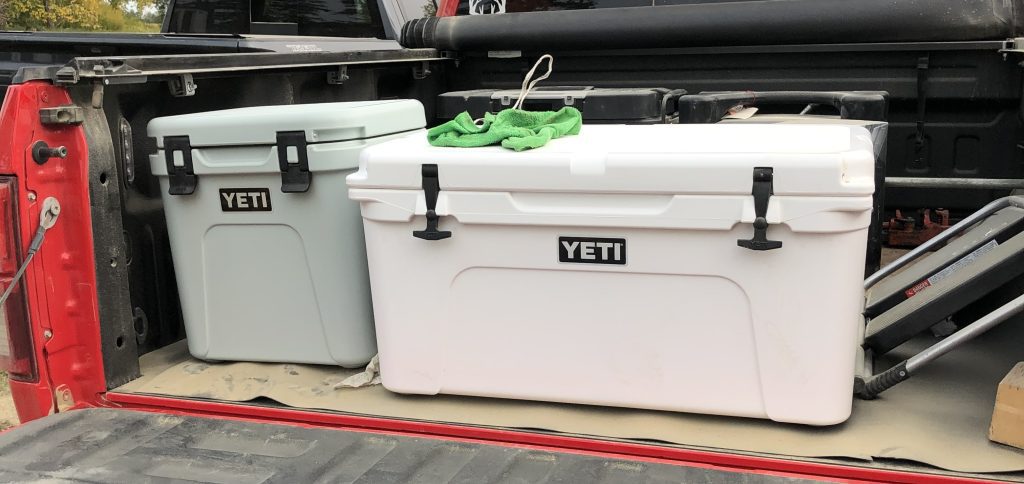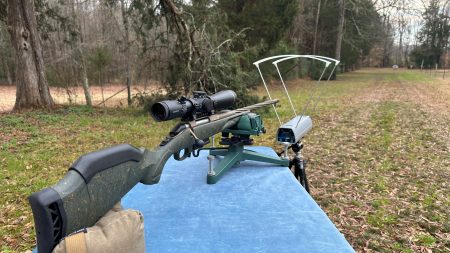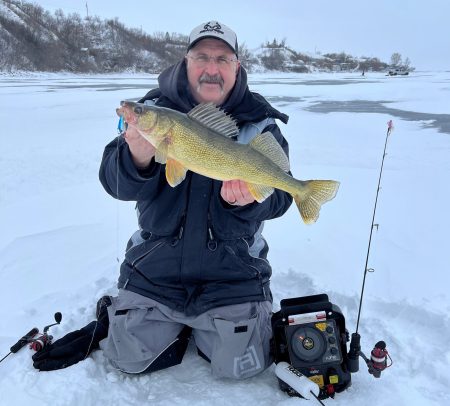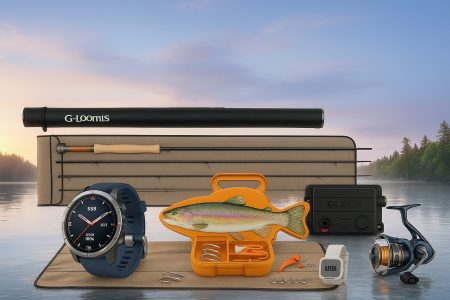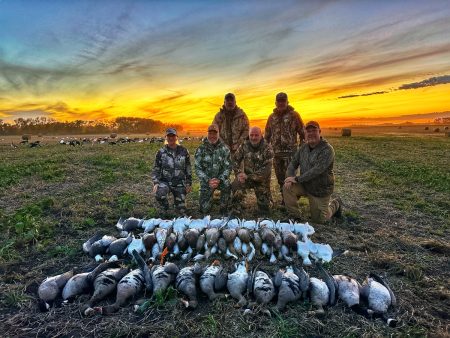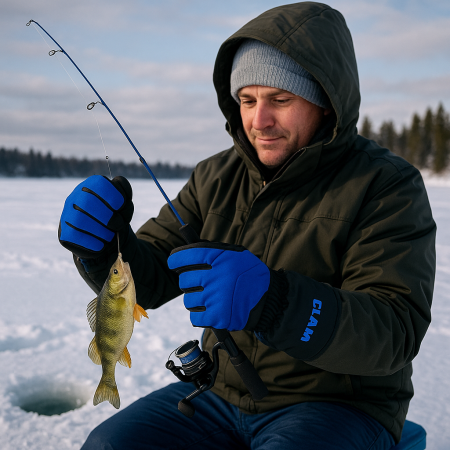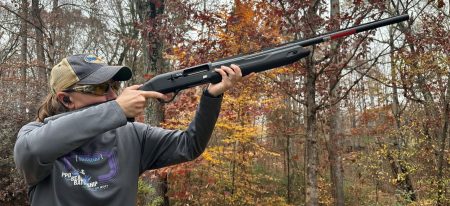Over almost 50 years of hunting, fishing and camping, I have used a number of coolers for my outdoor adventures. These coolers have stored food, beverages and fishing bait to keep those items protected from the elements. During that time, many of those coolers have failed to work or met a sad demise by cracking, having lids blow off, hinges break and even a couple got punctured by deer antlers.
These past few years, I have been switching out all of my coolers for Yeti coolers as I’m finding them extremely functional and extremely durable. Below is a summary of my top Yeti cooler selections and how I use them.
Tundra Series Yeti Hard Coolers
The Tundra series from Yeti hard coolers come in a variety of sizes ranging from the Tundra 35 that is capable of holding 29 pounds of ice or 39 cans to the Tundra 350 that is capable of handling 353 pounds of ice or 549 cans.
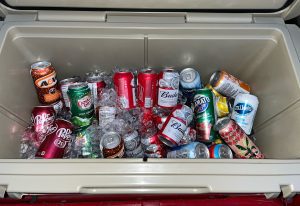
All the Tundra units are built using a rotational molding method that gives them incredible strength. They feature 3 inches of Permafrost Insulation, freezer quality rubber gaskets that create a tight seal, easy open/close T latches that stay shut, molded hand grips for single carry, rope handles with grooved rubber grips for two person carry and rubber feet to grip and prevent tip overs when travelling. These coolers can be made bear proof by using two long shank padlocks on the front corners of the coolers.
I use the Tundra coolers to carry food while hunting, fishing and camping. On remote and extended stay trips, I will pack more than one Tundra cooler. When doing so, I will pack one with fresh food and food to be consumed within the first few days. The other coolers will be packaged with frozen food and ice and then left unopened until I need to access the food. By keeping the coolers closed until needed the food in those coolers will remain frozen for multiple days. I use different colored units to tell them apart and create a list of what items are in each cooler so I know exactly what I am looking for when I open them up.
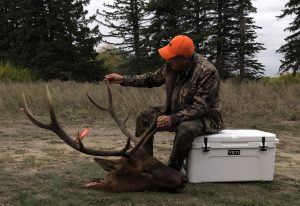
The largest of these Tundra coolers are ideal for commercial operations and large family events. They are also ideal to bring home quartered big game animals on early season hunts and take on deep sea and salmon fishing excursions to hold fish on ice so they don’t spoil while out on the water.

The smaller ones are well suited for any outdoor activity where you want to take food and beverages along with you or to bring home field dressed birds and fish. I will also use one of these coolers when icefishing, late season deer hunting and travelling to and from my home and cabin, to prevent food from freezing.
| Yeti Tundra – Pros | Yeti Tundra – Cons |
| – Keeps items cold for extended periods
– Rugged – Easy to clean – Have anchor point tie down slots – Comes with dry goods basket – Durable interlocking dual hinge pins – Drain plug – Easy to clean – Dry ice compatible – Stable to stand or sit on – Bear proof capable
|
– Heavy
– Internal size is smaller than expected – No lifetime warranty – 5 year warranty
|
Roadie Series Yeti Hard Coolers
The Roadie Series of coolers are smaller and taller versions than the Tundra coolers. They are designed to hold less and are ideal to take on short road trips or a one- or two-day outdoor excursion. They come in 3 sizes, the 24 that can hold 26 pounds of ice or 33 cans, the 48 that can hold holds 54 pounds of ice or 76 cans and the 60 that will hold 68 pounds of ice or 98 cans.
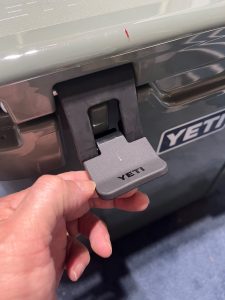
Similar to the Tundra Series of coolers, the Roadie coolers are also made using the rotational molding method that gives them incredible strength, feature Permafrost Insulation, freezer quality rubber gaskets that create a tight seal and slip proof rubber feet. These units utilize buckle style closure snaps. The 24 has a heavy-duty nylon carry strap with a plastic handle while the 48 and 60 have solid wheels and solid easy sliding periscope style handle to pull the units. These coolers can be also be made bear proof by using two long shank padlocks.
The 24 will fit perfectly on the floor behind the driver’s seat in a crew cab truck, while the 48 and 60 will fit well in the back of an SUV or truck box. I use the 24 to take field lunches while hunting and icefishing. I also use it to rest briskets and roasts once they come off the smoker.
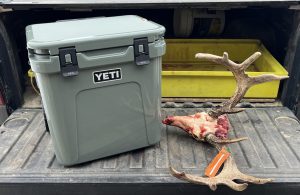
The 48 works very well for taking food and drinks on a hunting trip and is just the perfect size to allow you to bring a freshly skinned deer cape home after a successful hunt. If bringing a deer cape home in your cooler, I suggest you place a layer of ice on the bottom of the cooler and then place the cape in a heavy black garbage bag, so it doesn’t get wet and if any of the hair freezes, they won’t stick to the side of the cooler when you take it out.
| Yeti Roadie – Pros | Yeti Roadie – Cons |
| – Keeps items cold for extended periods
– Rugged – Easy to clean – 48 and 60 have Drain plugs – 48 and 60 come with dry goods basket – 48 and 60 have wheels – 48 and 60 have extendable handle – Easy to clean – Dry ice compatible – Taller profiler allows for wine and large pop bottles – Makes for a great seat – Bear proof capable
|
– Heavy
– Internal size is smaller than expected – No lifetime warranty – 5 year warranty – Dry good basket for 24 is an add on – 24 does not have wheels – Not leakproof – Taller design prone to tipping when standing on it |
Yeti Soft Coolers – Hopper Flip Series
The Yeti Hopper Flip series of soft coolers are soft sided zipper top coolers. They are rugged, leak proof and well insulated with closed cell rubber foam to keep food and beverages cold. Although the coolers are soft sided, they maintain their shape and don’t collapse.
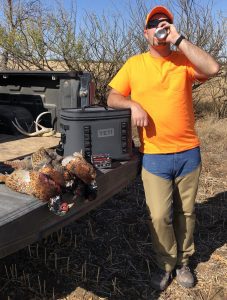
These coolers also come with a Hitchpoint Grid that allow you clip keys, towels, carabiners, bottle openers, umbrellas, etc. to the outside of the cooler. These coolers can be carried by a top handle, side handles or via clip on nylon carrying strap. The zipper on these coolers feature large plastic teeth and zip open on three full sides to help expose the entire cooler contents when opened. I have observed that young kids and smaller adults may find the zippers to be stiff to open. These coolers come in three sizes. The 8 which will hold 10 pounds of ice or 11 cans, the 12 which will hold 16 pounds of ice or 24 cans and the 18 which can hold 28 pounds of ice of 30 cans.
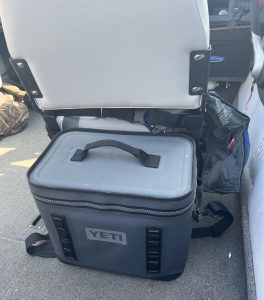
I really like these coolers for taking lunches and water and pop in a boat because if they slide around in the boat while battling waves, they are easy on your ankles, shins and knees. As well they typically won’t damage anything else they hit. They also shine when carried in the back seat of a truck for all the same reasons. Since they don’t leak and won’t collapse, I use a small one to carry fishing bait.
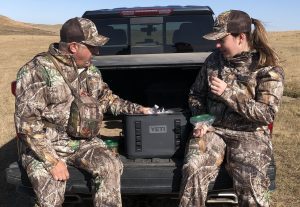
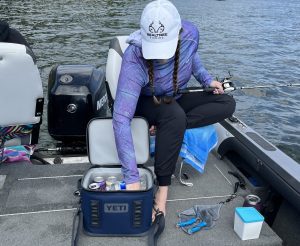
| Yeti Hopper Flip Series – Pros | Yeti Hopper Flip Series – Cons |
| – Keeps items cold for extended periods
– Rugged – Easy to clean – Soft Sided – Leakproof – Easy to clean – Easy on shins and ankles – Fits in most airline carryon compartments – Easy to carry – Light weight
|
– Zipper can be hard to open and close
– Not dry ice compatible – No lifetime warranty – 3 year warranty – No basket or dividers – No side pockets
|
Yeti Soft Coolers – M Series Backpack Coolers
Yeti has a second line of soft sided coolers called the M series which are soft sided back pack coolers. The idea behind these coolers is that you can wear them as a back pack so you can carry your food and beverages on your back, while keeping your hands free or to carry other items or perform activities such as hiking, walking down to the boat dock while carrying your fishing rod and tackle box or portaging a canoe.
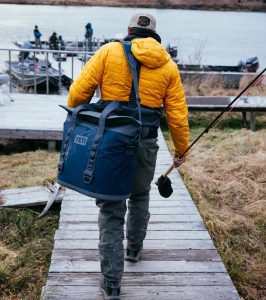
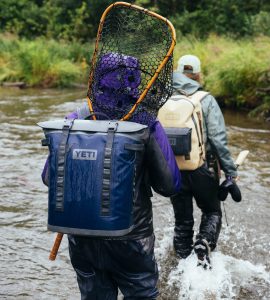
Just like the Hopper series, the M Series exterior is made of Yeti’s rugged DryHide material and has a Hitchpoint Grid for attaching accessories. Instead of zippers, these coolers feature a strong magnetic strip to seal the cooler shut and a set of buckles to further keep things closed. A few months ago, Yeti had a recall on this style of cooler as they were having issues with the magnets separating and becoming a potential choking hazard if someone put one in their mouth and swallowed it. Yeti went back to the drawing board and redesigned the closures. All new models have been enhanced to ensure there are no safety issues with the magnets. If you are unsure if you have a new model or an old model, contact Yeti Customer Service for assistance.
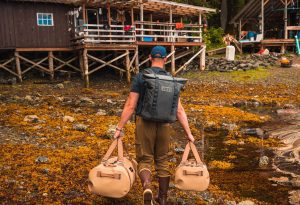
These back pack coolers are available in 2 sizes. The M12 is capable of hold 12 pounds of ice or 20 cans and the M20 will hold 22 pounds of ice or 36 cans. Yeti also make the M15 and an M30 soft sided coolers that are essentially the same build with a magnetic strip closure and large opening as the back pack style coolers. The major difference with these coolers is that instead of being a back pack carry cooler, they have a shoulder strap and carry handle. The M15 will hold 15 pounds of ice or 32 cans and the M30 will hold 32 pounds of ice or 42 cans.
| Yeti M Series – Pros | Yeti M Series – Cons |
| – Keeps items cold for extended periods
– Rugged Design – Easy to clean – Soft Sided – Has leak proof liner – M12 and M20 have strong back pack straps – Ergonomic design for easy carrying and weight distribution – Wide opening for easy access – Side handles for easy lifting |
– Not dry ice compatible
– Animals or small children could get entrapped in the cooler as they open up so wide and the magnets are strong if the opening closes – Magnets may interfere with pacemakers |
FAQ – Yeti Coolers
How do I keep ice longer in my Yeti cooler?
The key to keeping ice and food items frozen in your Yeti cooler for extended periods of time is to precondition the cooler prior to use. If you simply put cold or frozen items into a Yeti or any cooler for that matter, the cooler will draw coldness from those items until the temperature of the cooler walls and the items match. When this happens, the ice or frozen contents start to prematurely thaw.

To reduce and eliminate this natural process, pre condition your cooler a couple of days prior to using it. To do so, fill the cooler with ice or ice packs to cool off the interior of the cooler. Once the cooler has chilled, remove the ice packs and ice water and add then add new ice packs to the bottom, then your food and beverage and finally more ice packs and loose ice to fill any air pockets. To further help the cooler work, keep the lid closed until you need to open it. When the cooler is open quickly grab what you need and close the cooler back up to reduce the amount of time warm air gets inside the cooler. As well, try to store your cooler out of the direct sunlight.
Can I use my Yeti Cooler to keep things warm?
Insulated coolers can keep items hot or cold. If planning to keep food items hot, I suggest you wrap them in a towel or insulated blanket to help the goods stay warm. When cooking roasts and briskets on the smoker, to finish them and let them rest, I wrap them in tin foil, wrap with a towel and then seal them up in my cooler. If I want to make a gravy or suspect the meat might produce lots of liquid, I will put the tinfoil wrapped meat into a turkey bag before wrapping in a towel.
How does Yeti Coolers make the Tundra and Roadie coolers so durable?
Yeti manufactures these coolers using a rotational molding process. This style of manufacturing also known as rotomolding uses a high-temperature, low-pressure plastic forming process that uses heat and biaxial rotation (i.e., rotation on two axes) to produce hollow, one-piece parts. The YETI Cooler mold is loaded with polyethylene in powder form. The mold is then placed in a large oven while it rotates on two axes at different speeds, which helps prevent powder from accumulating in one spot. The polyethylene melts and adheres evenly to the wall of the mold. Once the polyethylene is melted, the molds are pulled out of the oven to cool. And once cool, the ice chest is then removed from the mold. The process has inherent design strengths, such as consistent wall thickness and strong outside corners that are virtually stress-free. The rotational molding process gives the coolers one-piece construction and unmatched durability. This is a very similar process to the manufacturing process used to make Kayaks.
How do I clean my Yeti Cooler?
After using my Yeti coolers, I will wash them with a hot soapy rag. Rinse them and towel them dry. On the models with drain plugs, I will partially fill the cooler with soapy water, wash the insides, remove the plug and hose them out. I always ensure to wash and dry the gasket areas and the drain plug holes as those areas tend to hold odors. For hard to remove stains and bad odors, use warm water and bleach with a 6:1 ratio with a sponge or mildly abrasive rag. Make sure the rag isn’t too abrasive or you will scratch your cooler. I will leave the cooler open until it is completely dry. I will then close the cooler and store until needed again.
How to the wheeled coolers work?
I have found the wheels on the Yeti coolers to be durable enough to take on rocky paths, gravel trails, on boat docks, through my garage and down the sidewalk. I have however found them to be a little difficult to pull in soft sand, especially when the cooler is full. As an added bonus, the wheels are non marring and won’t leave marks on the floor of a hall or gymnasium.
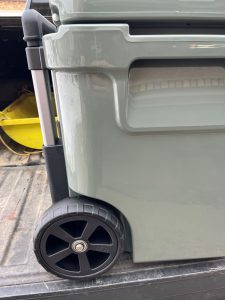
Per our affiliate disclosure, we may earn revenue from the products available on this page. To learn more about how we test gear, click here.






